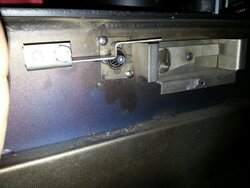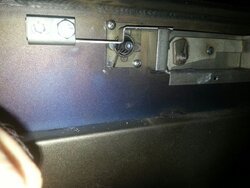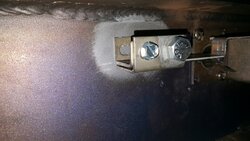Or just give them a good "tap" with a hammer before you back them out.
BB - Old helicopter mechanic
BB - Old helicopter mechanic
Tried the hammer trick too. Haven't tried the small sledge (kids are asleep, something to try later).Or just give them a good "tap" with a hammer before you back them out.
BB - Old helicopter mechanic




Hi folks,
Just joined today in order to rant about my Madison. So I don't seem like such a jerk, I will first say thanks to those who have posted this great information! The hours I've spent lurking here have helped a great deal with my liner install, selecting a wood stove, and gathering firewood.
I picked up my Madison from Lowes just a few weeks ago. It was $750 minus %10 because I had a coupon. No complaints there! My build date is 8/15 and serial is 003023. Because of this thread I checked my AAS before firing my new stove and it was indeed backwards. I made the repair but haven't tried the AAS yet because I'm still doing break in fires.
I get that it's a cheap stove, but I always get angry when I have to fix something that is BRAND NEW! I have other small complaints with the stove but a defect that could cause an overfire (if you weren't paying attention) is a little too much. And now we need to fix our new stoves instead of cutting firewood. Ain't nobody got time for that!
Oh well, I still think the stove is a good buy and I am excited about running it this winter. Rant over. Maybe ESW could send me a cord of dry oak...
View attachment 165546 View attachment 165547

Makes sense, if yours originally looked like that when warm it probably looked a lot like mine did when cold.I made the spring look like Michael's "correct" picture in post #43. I've done a few small break in fires but I haven't tried the AAS yet. I tested the spring with a lighter after the adjustment and it tripped after a while. I wanted to do the fix as early as possible to avoid breaking the screws.
Come to think of it, the stove was warm when I took the picture, I guess that's why the spring is where it is.
I can't wait for it to get cold so I can really test this thing. Looking forward to watching the lazy flames.

How did it work? It is sticking any more? My AAS is triggering at approximately 150 degrees as well. I haven't used it at all since my initial posts. I am going to wait until after the burning season to mess around back there. BTW. How did you get the spring to move. I was just bending the spring by turning the spring in the housing. Probably the wrong approach I'm sure. Any help would be good. Thanks so much.Last I tried using the AAS was November, and it wasn't working - it would trigger when it was cold. Finally took it apart to see.
The "S-shaped bracket" that releases the AAS was sticking in the "up" position, probably due to all my fiddling. I used graphite lube on its mating surface between the bracket and stove and bolt but I guess that didn't do the trick. This time I applied some anti-seize compound, hoping this'll be the ticket:
View attachment 170933
The S-bracket does not stick anymore (before applying anti-seize I could get the bracket to stick easily by fiddling with it, now I can't get it to stick). Don't crank down that bolt too much, just lightly tighten enough that the bracket doesn't have "too much" side-to-side play. We'll see tomorrow night when I fire it up...
Working pretty well now. I did see it "lingering" around 500F a while before finally delatching but it was close... me touching the lever a bit dropped it but I tried re-latching, and it de-latched again after some fiddling, so I think it was just "on the cusp". Both my wife and I have let it run with our full faith in the AAS and haven't been let down.How did it work? It is sticking any more? My AAS is triggering at approximately 150 degrees as well. I haven't used it at all since my initial posts. I am going to wait until after the burning season to mess around back there. BTW. How did you get the spring to move. I was just bending the spring by turning the spring in the housing. Probably the wrong approach I'm sure. Any help would be good. Thanks so much.
Mike Cardillo
Do you hear a metal-sliding/screeching sound as you move the damper in & out? If so, it's working fine. Can't say whether the AAS feature works or not (passively, without taking the rear heat shields off to inspect) until you've established your draft/etc works right and have experience using the stove manually (so you have a baseline for how fast the stove should heat up with your firewood in its current condition, etc).I just purchased a Madison stove and was wondering how I can tell if my damper is working properly. Seems I have to crack the door slightly before I get a good burn. Is this a result of poor draft or the damper not working? Also is there a way to make sure none of the stove pipe is leaking , especially around the joins? I have about 18 feet of chimney (prefab)
Cheers
Do you hear a metal-sliding/screeching sound as you move the damper in & out? If so, it's working fine. Can't say whether the AAS feature works or not (passively, without taking the rear heat shields off to inspect) until you've established your draft/etc works right and have experience using the stove manually (so you have a baseline for how fast the stove should heat up with your firewood in its current condition, etc).
Stove pipe leaks can be identified with a grill lighter, touch the flame near joints and see if the flame really gets sucked into them.

